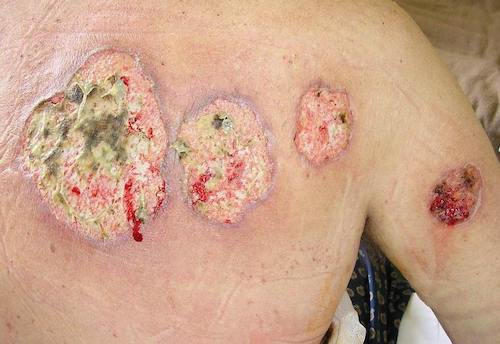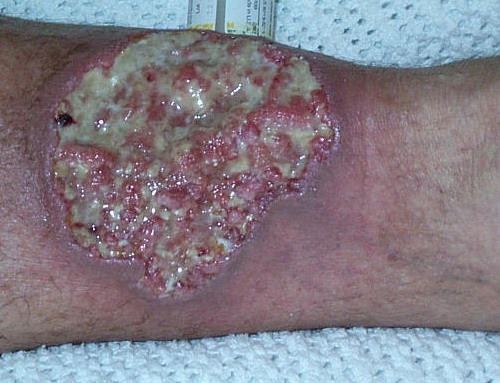Skin & Soft Tissue: Pyoderma Gangrenosum
Pyoderma Gangrenosum
Pathophysiology
- Definition: A Neutrophilic Dermatosis Causing Skin Inflammation & Ulceration
- Misnomer – Not Infectious & Not Gangrenous
- Neutrophil-Predominant Infiltration of the Skin
- Pathophysiology Not Entirely Certain
- Primary Factors:
- Neutrophil Dysfunction
- Systemic Inflammation
- Genetic Susceptibility
Associated Conditions
- More than 50% Have an Underlying Systemic Disease
- Inflammatory Bowel Disease (30-41%)
- Inflammatory Arthritis (21-25%)
- Solid Organ Malignancy (7%)
- Hematologic Malignancy (6%)
- Other Hematologic Disorders (5%)
Presentation
- Inflammatory Papule, Pustule or Nodule
- Expands Rapidly & Then Erodes/Ulcerates
- Severe Pain (Not Vegetative)
- Pathergy – Minor Trauma (Bump/Bruise) Progresses to Skin Lesions
- May Heal with Atrophic/Cribriform Scars
Subtypes
- Ulcerative (Classic) – Most Common Subtype
- Initial Inflammatory Lesion (Papule, Pustule or Nodule)
- Rapid Peripheral Expansion
- Central Degeneration & Ulceration
- Necrotic & Purulent Base with Bluish Edges
- Initial Inflammatory Lesion (Papule, Pustule or Nodule)
- Bullous (Atypical)
- Initial Blue-Gray Inflammatory Bullae
- Rapidly Erode with Superficial Ulceration
- Pustular
- Rapid Development of Painful Pustules
- Surrounded by Erythema
- Vegetative
- Superficial, Localized & Solitary Nodule or Ulcer
- Only Mildly Painful
- May Have a Verrucous Appearance

Pyoderma Gangrenosum 1

Pyoderma Gangrenosum 2
Sites
- Most Common Sites:
- Ulcerative: Lower Extremities & Thorax
- Bullous: Face & Arms
- Vegetative: Head & Neck
- Special Sites:
- Peristomal Pyoderma Gangrenosum
- Genital Pyoderma Gangrenosum
- Extracutaneous Pyoderma Gangrenosum (Lungs, Intestine, Liver, Spleen, etc.)
- Postoperative Pyoderma Gangrenosum (Surgical Site)
Diagnosis
- Other Diagnoses Must First Be Excluded
- Delphi Criteria:
- Require the Major Criteria & Four Minor Criteria
- Major Criteria:
- Biopsy of Ulcer Edge Showing Neutrophilic Infiltration
- Minor Criteria:
- Exclusion of Infection
- Pathergy
- Personal History of IBD or Inflammatory Arthritis
- History of Papule, Pustule or Vesicle that Rapidly Ulcerated
- Peripheral Erythema, Undermining Border & Tenderness at Site of Ulceration
- Multiple Ulcerations (At Least One on the Anterior Lower Leg)
- Cribriform or “Wrinkled Paper” Scars
- Decreased Ulcer Size within One Month of Starting Immunosuppressive Therapy
Treatment
- Treat Underlying Systemic Disease
- Immunosuppressive Therapy:
- Limited Disease: Topical Steroids or Calcineurin Inhibitors (Tacrolimus)
- Extensive/Rapidly Progressing: Systemic Steroids or Cyclosporine
- Prevention: May Consider Prophylactic Immunosuppressive Therapy Prior to Other Surgeries (Not Proven)
- Surgical Debridement
- Controversial & Done Only with Caution – Can Incite Pathergy
- Only Debride Clearly Necrotic Tissue
- Attempt to Limit Surgery to Periods of Good Disease Control
- Other Therapies:
- Infliximab (TNF-Alpha Inhibitor)
- Mycophenolate
- Methotrexate
- Azathioprine
- Intravenous Immunoglobulin (IVIG)
References
- Monopol. Wikimedia Commons. (License: CC BY-SA-3.0)
- Crohnie. Wikimedia Commons. (License: Public Domain)